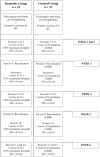Isometric versus isotonic exercise in individuals with rotator cuff tendinopathy-Effects on shoulder pain, functioning, muscle strength, and electromyographic activity: A protocol for randomized clinical trial
- PMID: 37956135
- PMCID: PMC10642785
- DOI: 10.1371/journal.pone.0293457
Isometric versus isotonic exercise in individuals with rotator cuff tendinopathy-Effects on shoulder pain, functioning, muscle strength, and electromyographic activity: A protocol for randomized clinical trial
Erratum in
-
Correction: Isometric versus isotonic exercise in individuals with rotator cuff tendinopathy-Effects on shoulder pain, functioning, muscle strength, and electromyographic activity: A protocol for randomized clinical trial.PLoS One. 2024 Jan 19;19(1):e0297630. doi: 10.1371/journal.pone.0297630. eCollection 2024. PLoS One. 2024. PMID: 38241237 Free PMC article.
Abstract
Introduction: Rotator cuff tendinopathy is a common shoulder disorder in which the primary treatment is resistance exercises. Isometric exercises are being studied for lower limb tendinopathies but not for rotator cuff tendinopathy. This protocol for a randomized clinical trial aims to compare the effects of two types of exercise (isometric and isotonic) on shoulder pain, functioning, muscle strength, and electromyographic activity in individuals with rotator cuff tendinopathy.
Methods: Forty-six individuals (18 to 60 years old) with shoulder pain for more than three months and unilateral supraspinatus and/or infraspinatus tendinopathy will participate in this trial. Individuals will be randomized into two exercise groups: isometric or isotonic. The following outcomes will be evaluated before and after the first session and after six weeks of intervention: shoulder pain and functioning; isometric strength of shoulder elevation and lateral and medial rotation; and electromyographic activity of medial deltoid, infraspinatus, serratus anterior, and lower trapezius. Groups will perform stretching and strengthening of periscapular muscles. The isometric group will perform three sets of 32 s, at 70% of maximal isometric strength. The isotonic group will perform concentric and eccentric exercises (2 s for each phase) in three sets of eight repetitions at a load of eight repetition maximum. The total time under tension of 96 s will be equal for both groups, and load will be adjusted in weeks three and five of the protocol. Treatment effect between groups will be analyzed using linear mixed model.
Trial registration: Trial registration number: Universal Trial Number (UTN) code U1111-1284-7528 and Brazilian Clinical Trials Registry platform-RBR-3pvdvfk.
Copyright: © 2023 Rodrigues da Silva Barros et al. This is an open access article distributed under the terms of the Creative Commons Attribution License, which permits unrestricted use, distribution, and reproduction in any medium, provided the original author and source are credited.
Conflict of interest statement
The authors have declared that no competing interests exist.
Figures






References
-
- Lewis J. Rotator cuff related shoulder pain: Assessment, management and uncertainties. Man Ther. 2015;23:57–68. - PubMed
-
- Dang A, Davies M. Rotator Cuff Disease: Treatment Options and Considerations [Internet]. 2018. www.sportsmedarthro.com. - PubMed
-
- Leong HT, Fu SC, He X, Oh JH, Yamamoto N, Yung SHP. Risk factors for rotator cuff tendinopathy: A systematic review and meta-analysis. Vol. 51, Journal of Rehabilitation Medicine. Foundation for Rehabilitation Information; 2019. p. 627–37. - PubMed
Publication types
MeSH terms
LinkOut - more resources
Full Text Sources
Medical

